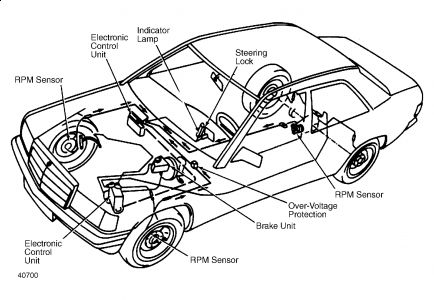The ABS Hydraulic control unit can only be tested with a special ABS tester from M/B and can only be replaced as a UNIT you cannot break it down to check it works ! .. I have a dealer part price for the ABS Hydraulic Unit of $2000.00 ... so you may want to look aftermarket/reconditioned or from a car recycle yard
TESTING WITH ABS TESTER
NOTE:DO NOT drive vehicle with tester connected.
Connecting Tester
With ignition off, disconnect 35-pole connector of cable harness from electronic control unit.
Connect 35-pole connector to plug of ABS Test Adaptor (126-589-09-21-00). Make sure that all other electrical components are off before turning ignition on.
Connect multimeter to test adapter. This adapter permits testing the complete ABS system, except the electronic control unit.
TEST 8
Testing Internal Resistance Of Solenoid Valves
Set multimeter to "OHMS" position. Ignition off. Push ground button. Rotary switch moved successively to positions 8, 9 and 10.
Resistance should be 0.7-1.7 ohms. If internal resistance is under .07 ohms or over 1.7 ohms, go to step 3).
Check for poor contact at plug connector on hydraulic unit, interrupted connecting wires or defective hydraulic unit.
TEST 9
Testing Pressure Holding Of Solenoid Valves
Ignition on. Rotary switch moved successively to positions 8, 9 and 10. Spin respective wheel. Press "P" push button. Actuate brake pedal.
Wheel should permit turning and no brake force should build up. If not okay, go to step 3).
Check for defective motor relay, return pump, or solenoid valve. Replace as necessary.
TEST 10
Testing Pressure Reduction Of Solenoid Valve
Ignition on. Rotary switch moved successively to positions 8, 9 and 10. Actuate brake pedal. Press "P" button. Turn respective wheel.
Introduced brake force should be reducing. Return pump should be running. If not, proceed to step 3).
Check for defective motor relay, return pump, or solenoid valve. Replace as necessary.
TEST 11
NOTE:Stoplight switch is connected to 35-pole plug at pin 25.
Testing Overvoltage Protection Relay
Ignition on. Actuate brake pedal. LED indicator "0" should come on. If not, check connecting wires or replace stoplight switch.
****MANUAL BLEEDING
On Isuzu and Jaguar models, start engine and run at idle. On all other models, exhaust all vacuum from power unit by depressing brake pedal several times.
Fill master cylinder, then install clear vinyl bleeder hose onto first bleeder valve to be serviced.
NOTE:On manual transmission vehicles where clutch master cylinder feeds from brake master cylinder, bleed clutch cylinder first.
Place other end of hose in clear glass jar.
3) Partially fill jar with clean brake fluid, so end of hose is submerged in fluid. Open bleeder valve 1-2 turns. Depress brake pedal slowly through its full travel.
4) Close bleeder valve, then release pedal. Pump pedal several times to push air toward wheel cylinders. Repeat procedure until flow of brake fluid is clear, and shows no signs of air bubbles. Proceed to next bleeder valves.
NOTE:Check fluid level in master cylinder frequently during the bleeding sequence.
hope this helps

Thursday, December 3rd, 2009 AT 4:50 AM






